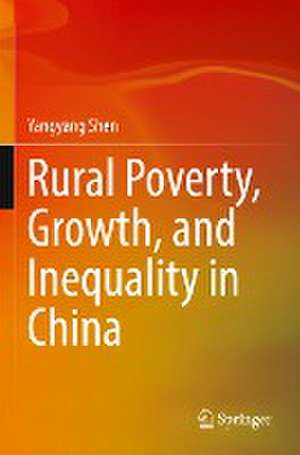Rural Poverty, Growth, and Inequality in China
Autor Yangyang Shenen Limba Engleză Paperback – 26 feb 2023
This book aims to empirically and theoretically study how the economic growth and inequality affected China’s rural poverty since China’s reform and opening-up. Apart from the trickle-down effect, some empirical researches show that rising inequality usually links with unfairly shared of the economic growth, which is not good for the poor, and this book particularly concerns with the impact of inequality on poverty reduction. In 11 chapters, it leads readers to review the dynamic changes of rural poverty in China, and estimates rural poverty by various methods, for instance, with analysis by monetary poverty (including income and expenditure poverty), multidimensional poverty, absolute poverty, and relative poverty. Especially attention is paid to apply the “growth-inequality-poverty triangle” model for long-term poverty dynamic changes evaluation. The book revisits poverty reduction strategies in different development periods for rural China and evaluates the poverty eradicationachievements stage-by-stage under different analytical methods, in order to provide an objective assessment. Among the chapters, pro-poor growth, Shapley decomposition, poverty elasticity, density estimation, multidimensional poverty analysis, and policy simulation methods are applied for both national wide discussion and rural sub-group heterogeneity analysis.
In addition to students, teachers, and researchers in the areas of development, economic growth, equity, and welfare, the book is also of great interest to policy makers, planners, and non‐government agencies who are concerned with understanding and addressing poverty-related issues in the developing countries.
| Toate formatele și edițiile | Preț | Express |
|---|---|---|
| Paperback (1) | 697.15 lei 6-8 săpt. | |
| Springer Nature Singapore – 26 feb 2023 | 697.15 lei 6-8 săpt. | |
| Hardback (1) | 703.52 lei 6-8 săpt. | |
| Springer Nature Singapore – 25 feb 2022 | 703.52 lei 6-8 săpt. |
Preț: 697.15 lei
Preț vechi: 820.18 lei
-15% Nou
Puncte Express: 1046
Preț estimativ în valută:
133.40€ • 145.36$ • 112.41£
133.40€ • 145.36$ • 112.41£
Carte tipărită la comandă
Livrare economică 23 aprilie-07 mai
Preluare comenzi: 021 569.72.76
Specificații
ISBN-13: 9789811697388
ISBN-10: 9811697388
Pagini: 285
Ilustrații: XV, 285 p. 33 illus., 3 illus. in color.
Dimensiuni: 155 x 235 mm
Greutate: 0.43 kg
Ediția:1st ed. 2022
Editura: Springer Nature Singapore
Colecția Springer
Locul publicării:Singapore, Singapore
ISBN-10: 9811697388
Pagini: 285
Ilustrații: XV, 285 p. 33 illus., 3 illus. in color.
Dimensiuni: 155 x 235 mm
Greutate: 0.43 kg
Ediția:1st ed. 2022
Editura: Springer Nature Singapore
Colecția Springer
Locul publicării:Singapore, Singapore
Cuprins
Preface.- Chapter 1 Poverty Alleviation Process in Rural China.- Chapter 2 Literature Review.- Chapter 3 Absolute and Relative Changes in Rural Poverty.- Chapter 4 Pro-poor Growth for Rural China.- Chapter 5 The Decomposition of Income Growth and Income Inequality on Rural Poverty.- Chapter 6 Types of Economic Activities and Rural Residents’ Poverty Dynamic Changes.- Chapter 7 Human Capital and Rural Residents’ Poverty Dynamic Changes.- Chapter 8 Dynamic Rural Poverty Changes by Regions: Current Status and Prospects.- Chapter 9 The Impacts of Unbalanced Development on Rural Multidimensional Poverty.- Chapter 10 Relieving Relative Poverty in Rural China.- Appendix
Notă biografică
Yangyang Shen is Associate Professor of Economics at the School of Economics and Resource Management, Beijing Normal University. She holds a Ph.D. in Economics from Nankai University. She was Postdoc at Business School of Beijing Normal University and Research Officer at Oxford Poverty and Human Initiative (OPHI), University of Oxford. Her research interests include development economics, welfare economics, income inequality, and poverty. Recently, her research work focuses on China’s poverty reduction policy evaluation and multidimensional poverty dynamic evolutions. She has co-authored three books and published journal at China & World Economy, Public Health, and over 30 Chinese academic journals.
Textul de pe ultima copertă
This book aims to empirically and theoretically study how the economic growth and inequality affected China’s rural poverty since China’s reform and opening-up. Apart from the trickle-down effect, some empirical researches show that rising inequality usually links with unfairly shared of the economic growth, which is not good for the poor, and this book particularly concerns with the impact of inequality on poverty reduction. In 11 chapters, it leads readers to review the dynamic changes of rural poverty in China, and estimates rural poverty by various methods, for instance, with analysis by monetary poverty (including income and expenditure poverty), multidimensional poverty, absolute poverty, and relative poverty. Especially attention is paid to apply the “growth-inequality-poverty triangle” model for long-term poverty dynamic changes evaluation. The book revisits poverty reduction strategies in different development periods for rural China and evaluates the poverty eradicationachievements stage-by-stage under different analytical methods, in order to provide an objective assessment. Among the chapters, pro-poor growth, Shapley decomposition, poverty elasticity, density estimation, multidimensional poverty analysis, and policy simulation methods are applied for both national wide discussion and rural sub-group heterogeneity analysis.
In addition to students, teachers, and researchers in the areas of development, economic growth, equity, and welfare, the book is also of great interest to policy makers, planners, and non‐government agencies who are concerned with understanding and addressing poverty-related issues in the developing countries.
Caracteristici
Explores rural poverty for over the past 40 years in China and studies the dynamic changes from many perspectives Uncovers the macro-factors enabling poverty from the perspective of economic growth and inequality Throws light on policy implication for China's establishment of a long-term mechanism for poverty alleviation
